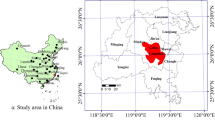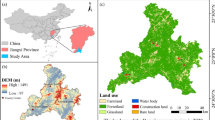Abstract
As the global ecosystem has been severely disturbed by an increasing number of human activities at different scales, remote sensing technology, as an effective quantitative measure of environmental quality, has been widely used. The remote sensing ecological index (RSEI) is one of the most popular and comprehensive ecological quality assessment indices based on the remote sensing data. However, the RSEI model exhibits that the ecological environment under natural conditions is not limited by the spatial scales. In addition, the model has major shortcomings in index selection and eigenvector, which greatly limit the application of RSEI. In this paper, the RSEI model is improved and a remote sensing ecological index optimized by the regional scale (RO-RSEI) is proposed. The result of the study, conducted in Shuangyang District, Changchun City, Jilin Province, shows that the RO-RSEI model has regional ecological significance after the introduction of the scale theory of landscape ecology; the index is preferred to solve problems like the RSEI model applied mechanization and baseless index selection. Meanwhile, due to the optimization of the eigenvector contribution of the optimal index, it solves the problems like non-unique model calculation result caused by principal component analysis or even antipodal calculation result. Compared with the RSEI model, the monitoring result of RO-RSEI model can better reflect the regional ecological changes. The improved model offers the possibility of monitoring ecological environment quality with remote sensing big data and provides a scientific basis for future scholars’ batch computing.









Similar content being viewed by others
Data availability
The data sources used in the current research are all public data (the data sources are listed in the first section of the article).
References
Alcaraz-Segura D, Lomba A, Sousa-Silva R, Nieto-Lugilde D, Alves P, Georges D, Vicente JR, Honrado JP (2017) Potential of satellite-derived ecosystem functional attributes to anticipate species range shifts. Int J Appl Earth Obs 57:86–92
Bai LM (2019) Evaluation and optimization of urban ecological resilience in Changchun based on landscape pattern.Master.Northeast Normal University, Changchun
Chander G, Markham BL, Helder DL (2009) Summary of current radiometric calibration coefficients for Landsat MSS, TM, ETM+, and EO-1 ALI sensors. Remo Sens Environ 113(5):893–903
Chen WL, Liu YH, Guan CH, Wang JJ (2010) The discussion about the scope of ecological impact assessment. Envir Scie Manag 35(12):185–189
Chen Q, Hang MR, Guo Z (2020) Spatial evolution characteristics of summer surface temperature in Xian City. Map.scie 45(11):139–146
Crist EP (1985) A TM Tasseled cap equivalent transformation for reflectance factor data. Remo Sens Envion 17(3):301–306
De Araujo Barbosa CC, Atkinson PM, Dearing JA (2015) Remote sensing of ecosystem services: a systematic review. Ecol Indic 52:430–443
Dizdaroglu D, Yigitcanlar T (2012) Dawes, L.A micro-level indexing model for assessing urban ecosystem sustainability. Smar Sust Buil Envi 1(3):291–315
Gao PW, Kasim A, Ruzi T, Zhao MC (2020) Temporal and spatial analysis of ecological environment improvement in Hami City. Arid Zone Research 37(04):1057–1067
Healey SP, Cohen WB, Yang ZQ, Krankina ON (2005) Comparison of tasseled cap-based Landsat data structures for use in forest disturbance detection. Remote Sens Environ 97:301–310
Ivits E, Buchanan G, Olsvig-Whittaker L, Cherlet M (2011) European farmland bird distribution explained by remotely sensed phenological indices. Environ Model Assess 16:385–399
Jaafari S, Sakieh Y, Shabani AA, Danehkar A, Nazarisamani A (2016) Landscape change assessment of reservation areas using remote sensing and landscape metrics (case study: Jajroud reservation, Iran). Envi Deve Sust 18(6):1701–1717
Li C, Li XM, Tian YL, Ren R (2020a) Time and space fusion model comparison of temperature vegetation drought index. Remo Sen Tech Appl 35(04):832–844
Li N, Wang JY, Qin F (2020b) The improvement of ecological environment index model RSEI. Arab J Geosci 13(12):132–137
Liu XY; Zhang XX;He YR;Luan HJ (2020a) Monitoring and assessment of ecological change in coastal cities based on RSEI, XLII-3/W10:461-470
Liu Y, Qi JW, Lu HZ, Wang GH, Gao XY, Wang J, Zhang T (2020b) Monitoring and analysis of the change of ecological environment in Qingdao based on remote sensing technologies. Bull Surv Map 09:60–65
Maleky M;Razavi B 2013 Hasanfathizadeh. Land use change analysis using gis, remote sensing and landscape metrics(case study: Kermanshahcity, Iran). 34th Asian Conference on Remote Sensing, (01):864–881
Mao ZC, Song Y, Li MM (2015) Research of the desertification in Hetao area based on MODIS inversion data. Jour Pek Univ 51(06):1102–1110
Marden JI (1999) Some robust estimates of principal components. Statistics & Probability Letters 43(4):349–359
Marull J, Pino J, Mallarach JM et al (2006) A land suitability index for strategic environmental assessment in metropolitan areas. Landsc Urban Plan 81(3):200–212
McDonnnell MJ, MacGregor-Fors I (2016) The ecological future of cities. Science. 352:936–938
Mei ZR, Li YJ, Kang X, Wei SB, Pan JJ (2019) Temporal and spatial evolution in landscape pattern of mining site area based on moving window method. Remo Sens Land Resou 31(04):60–68
Michael EM (2000) EMAP Overview: objectives, approaches, and achievements. Envi Moni Asse 64(1):1–8
Mildrexler DJ, Zhao M, Running SW (2009) Testing a MODIS global disturbance index across North America. Remote Sens Environ 113:2103–2117
Ouyang ZY, Wang Q, Zhang H, Zhang F, Hou P (2014) National ecosystem survey and assessment of China(2000-2010). Bull Chin Acad Sci 29:462–466
Pan ZH (2020) Study on ecological impact assessment of coal mining based on modify ecological index in arid desert area of northwest China. Master, China University of Geosciences, Beijing
Qi Tao (2007) The study of regional vegetation ecological environment quality integrative evaluation based-on remote sensing. Master. Huazhong University of Science and Technology, Wuhan
Qiao M, Zhang YB, Yu TB (2020) Dynamic monitoring of ecological environment quality in Beijing based on remote sensing ecological index. Jour North China Univ Scie Tech 42(04):17–23
Rhee J, Im J, Carbone GJ (2010) Monitoring agricultural drought for arid and humid regions using multi-sensor remote sensing data. Remote Sens Environ 114:2875–2887
Rukeya S, Abuduheni A, Li H, Nijat K, Li XH (2020) Dynamic monitoring and analysis of ecological environment in Fukang City vased on RSEI model. Resea Soil Wate Conser 27(01):283–289+297
Samuel NG, Xue YK, Kevin PC (2002) Evaluating land surface moisture conditions from the remotely sensed temperature/vegetation index measurements: an exploration with the simplified simple biosphere model. Remo Sens Envion 79(2):225–242
Schell JA (1973) Monitoring vegetation systems in the great plains with ERTS. Nasa Special Publication 351:309
Shi SE, Wei W, Yang D, Hu X, Zhou JJ, Zhang Q (2018) Spatial and temporal evolution of eco-environmental quality in the oasis of Shiyang River Basin based on RSEDI. Chinese Journal of Ecology 37(04):1152–1163
Shi TT, Xu HQ, Wang S (2019) Derivation of tasselled cap transformation coefficients for ZY-3 MUX sensordata. J Remo Sens 23(3):514–525
Song MJ, Luo YY, Duan LM (2019) Evaluation of ecological environment in the Xilin Gol steppe based on modified remote sensing ecological index model. Arid Zone Research 36(06):1521–1527
Sun CJ, Zhang WQ, Li XG, Sun JL (2019) Evaluation of ecological effect of gully region of loess plateau based on remote sensing image. Trans Chin Soci Agri Engin 35(12):165–172
Tiner RW (2004) Remotely-sensed indicators for monitoring the general condition of “natural habitat” in watersheds: an application for Delaware’s Nanticoke River watershed. Ecol Indic 4:227–243
Wang XF (2010) Study on eco-environmental cumulative effects in coal mining area. Doctor ,China University of Mining and Technology,Xuzhou
Wang XH (2020) Evaluation of highway ecological environment impact in Tibet based on remote sensing index. Master, Tianjin Normal University, Tianjin
Wang Y, Wang SD (2019) Dynamic change analysis of ecological quality based on RSEI: a case study of the Danjiang River Basin (Henan sectiom). Scie Soil Water Conser 17(0):57–65
Wang L, Wang PX, Li L, Zhang SY (2017) Winter wheat yield estimation method based on quantile regression model and remotely sensed vegetation temperature condition Index. J Agri Mach 48(07):167–173+166
Wang DZ, Wang SM, Huang C (2019a) Comparison of Sentinel-2 imagery with Landsat8 imagery for surface water extraction using four common water indexes. Remo Sens Land Resou 31(03):157–165
Wang LC, Jiao L, Lai FB, Dai PC (2019b) Study on evaluation and driving forces of ecological changes in Jinghe County, Xinjiang. J Ecol Environment 35(03):316–323
Wang J, Ma JL, Xie PP, Xu XJ (2020) Improvement of remote sensing ecological index in arid regions: taking Ulan Buh Desert as an example. Chin Jour Appl Ecol 31(11):3795–3804
Willis KS (2015) Remote sensing change detection for ecological monitoring in United States protected areas. Biol Conserv 182:233–242
Wu J (2004) Effects of changing scale on landscape pattern analysis: scaling relations. Land Ecology 19(2):125–138
Wu J, Meng QY, Zhan YL (2016) A measure of urban green index in urban areas based on moving window method. J Geo Scie 18(4):544–552
Xu HQ (2005) A study on information extraction of water body with the modified normalized difference water index (MNDWI). Journal of Remote Sensing 05:589–595
Xu HQ (2013a) A remote sensing index for assessment of regional ecological changes. China Environ Sci 33(05):889–897
Xu HQ (2013b) A remote sensing urban ecological index and its application. Acta Ecol Sin 33(24):7853–7862
Xu HQ, Wang YF, Guan HD, Shi TT, Hu XS (2019) Detecting ecological changes with a remote sensing based ecological index (RSEI) produced time series and change vector analysis. Remote Sens 11(20):2345. https://doi.org/10.3390/rs11202345
Xu JH, Zhao Y, Xiao MH, Zhong KW, Ruan HH (2018) Relationship of air temperature to NDVI and NDBI in Guangzhou City using spatial autoregressive model. Remo.Sens.Land.Resou. 30(02):186–194
Zha Y, Gao J, Ni S (2003) Use of normalized difference built-up index in automatically mapping urban areas from TM imagery. Inter Jour Rem Sens 24(3):583–594
Zhang LF, Qiao N, Baig H, Huang CP, Lv X, SUN XJ, Zhang Z (2019) Monitoring vegetation dynamics using the universal normalized vegetation index (UNVI): an optimized vegetation index-VIUPD. Remo Sens Lett 10(7)
Zhang YQ, Jiang F, Ji MD, Jiang HS, Wang ZY (2020) Assessment of ecological environment at district and county level based on remote sensing index. Arid Zone Research 37(06):1598–1605
Zhao JW, Wang KL, Ou Yang Q, Cheng QS (2011) Measurement of chlorophyll content and distribution in tea plant’s leaf using hyperspectral imaging technique. Spect Anal 31(02):512–515
Zhu RJ (2017) Evaluation of environment quality of Nanchang based on remote sensing based on ecological index. Master, East China University of Technology, Nanchang
Zhu DY, Chen T, Zhen N, Niu RQ (2020a) Monitoring the effects of open-pit mining on the eco-environment using a moving window-based remote sensing ecological index. Envi Scie Poll Reas 27(3):15716–15728
Zhu DY, Chen T, Niu RQ, Zhen N (2020b) Ecological environment monitoring and assessment of mining area base on moving window-based remote sensing ecological index. Geom Infor Scie:1–8
Funding
This research was funded by the Jilin Provincial Department of Education Project, grant numbers: JJKH201911246KJ and JJKH20191267KJ.
Author information
Authors and Affiliations
Contributions
Conceptualization: Fang Jiang, Yaqiu Zhang. Methodology: Fang Jiang, Yaqiu Zhang, Junyao Li, Zhiyong Sun. Writing: Yaqiu Zhang, Junyao Li. Visualization: Yaqiu Zhang, Junyao Li. Funding acquisition: Fang Jiang, Zhiyong Sun
Corresponding author
Ethics declarations
Ethics approval
Ethics approval was not required for this research.
Consent to participate
The authors declare consent to participate.
Consent to publish
The authors declare consent to publish.
Conflict of interest
The authors declare no competing interests.
Additional information
Responsible Editor: Philipp Gariguess
Publisher’s note
Springer Nature remains neutral with regard to jurisdictional claims in published maps and institutional affiliations.
Rights and permissions
About this article
Cite this article
Jiang, F., Zhang, Y., Li, J. et al. Research on remote sensing ecological environmental assessment method optimized by regional scale. Environ Sci Pollut Res 28, 68174–68187 (2021). https://doi.org/10.1007/s11356-021-15262-x
Received:
Accepted:
Published:
Issue Date:
DOI: https://doi.org/10.1007/s11356-021-15262-x




